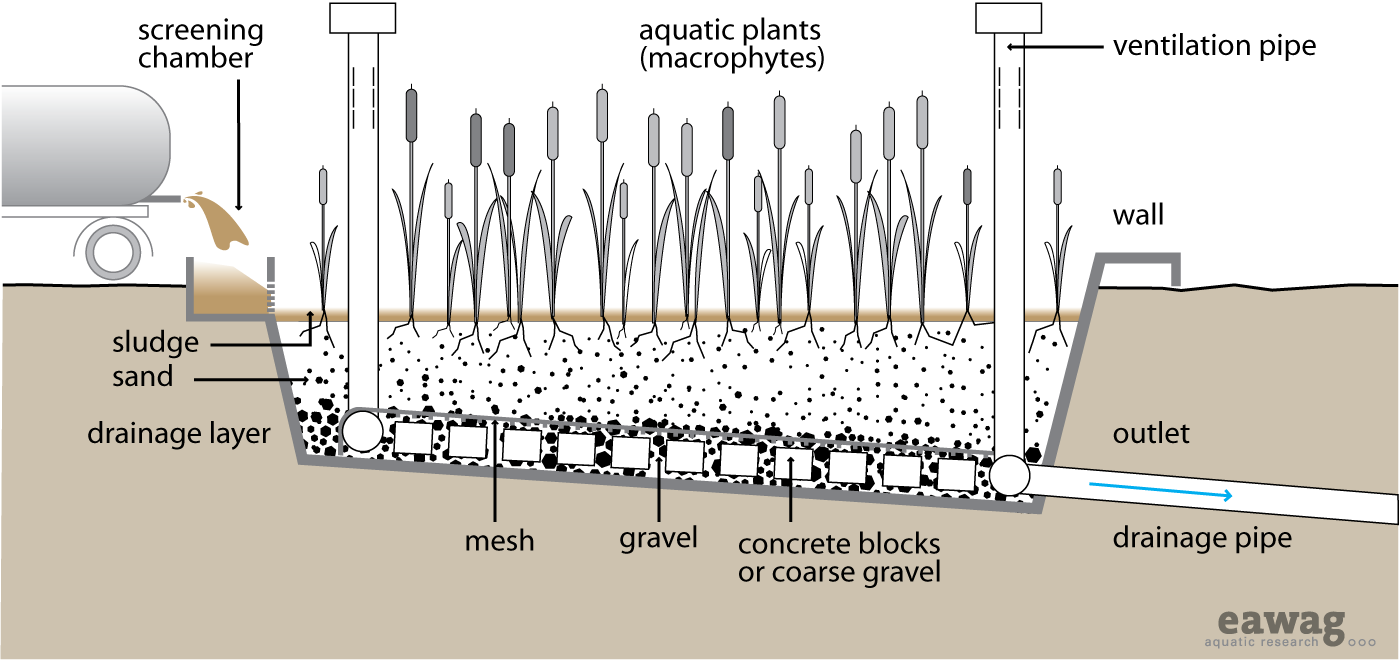Planted Drying Beds
|

|
|
| |||||||||||||||||||||||||||||||
A Planted Drying Bed is similar to an Unplanted Drying Bed with the benefit of increased transpiration. The key feature is that the filters do not need to be desludged after each feeding/drying cycle. Fresh sludge can be applied directly onto the previous layer; it is the plants and their root systems that maintain the porosity of the filter.
This technology has the benefit of dewatering as well as stabilizing the sludge. Also, the roots of the plants create pathways through the thickening sludge to allow water to escape more easily.
The appearance of the bed is similar to a Vertical Flow Constructed Wetland. The beds are filled with sand and gravel to support the vegetation. Instead of effluent, sludge is applied to the surface and the filtrate flows down through the subsurface to collect in drains. A general design for layering the bed is: (1) 250mm of coarse gravel (grain diameter of 20mm); (2) 250mm of fine gravel (grain diameter of 5 mm); and (3) 100–150mm of sand. Free space (1m) should be left above the top of the sand layer to account for about 3 to 5 years of accumulation.
When the bed is constructed, the plants should be planted evenly and allowed to establish themselves before the sludge is applied. Echinochloa pyramidalis, Cattails or Phragmites are suitable plants depending on the climate.
Sludge should be applied in layers between 75 to 100mm and should be reapplied every 3 to 7 days depending on the sludge characteristics, the environment and operating constraints. Sludge application rates of up to 250kg/m2/year have been reported. The sludge can be removed after 2 to 3 years (although the degree of hygienization will vary with climate) and used for agriculture.
| Advantages | Disadvantages/limitations |
|---|---|
| - Can handle high loading. - Fruit or forage growing can generate income. - Can be built and repaired with locally available materials. - Low capital cost; low operating cost. - Potential for local job creation and income generation. - No electrical energy required. |
- Requires large land area. - Odours and flies are normally noticeable. - Long storage times. - Requires expert design and operation. - Labour intensive removal. - Leachate requires secondary treatment. |
Adequacy
This is an effective technology at decreasing sludge volume (down to 50%) through decomposition and drying, which is especially important when the sludge needs to be transported elsewhere for direct use, Co-composting, or disposal. Planted drying beds are appropriate for small to medium communities with populations up to 100,000 people.
It should be located on the edge of the community. The sludge is not hygienized and requires further treat ment before disposal. Ideally this technology should be coupled with a Co-Composting facility to generate a hygienic product.
Trained staff for operation and maintenance is required to ensure proper functioning.
Health Aspects/Acceptance
Because of the pleasing aesthetics, there should be few problems with acceptance, especially if located away dense housing. Faecal sludge is hazardous and anyone working with it should wear protective clothing, boots and gloves.
Maintenance
The drains must be maintained and the effluent must be properly collected and disposed of. The plants should be periodically thinned and/or harvested.
References
- Elizabeth Tilley et.al (2008). Compendium of Sanitation Systems and Technologies (low res version). Department of Water and Sanitation in Development Countries (Sandec) at the Swiss Federal Institute of Aquatic Science and Technology (Eawag). (Provides a full overview of sanitation systems.)
- Crites, R. and Tchobanoglous, G. (1998). Small and Decentralized Wastewater Management Systems. WCB and McGraw-Hill, New York, USA.
- Heinss, U. and Koottatep, T. (1998). Use of Reed Beds for Faecal Sludge Dewatering - A Synopsis of Reviewed Literature and Interim Results of Pilot Investigations with Septage Treatment in Bangkok, Thailand. UEEM Program Report , AIT/EAWAG, Dübendorf, Switzerland. Available: http://www.sandec.ch
- Koottatep, T., et al. (2004). Treatment of septage in constructed wetlands in tropical climate – Lessons learnt after seven years of operation. Water Science & Technology, 51(9): 119–126. Available: http://www.sandec.ch
- Montangero, A. and Strauss, M. (2002). Faecal Sludge Treatment. Lecture Notes, IHE Delft. Available: http://www.sandec.ch
- Tchobanoglous, G., Burton, FL. and Stensel, HD. (2003). Wastewater Engineering: Treatment and Reuse, 4th Edition. Metcalf & Eddy, New York, pp 1578.
- Kengne Noumsi, IM. (2008). Potentials of Sludge drying beds vegetated with Cyperus papyrus L. and Echinochloa pyramidalis (Lam.) Hitchc. & Chase for faecal Sludge treatment in tropical regions. [PhD dissertation]. Yaounde (Cameroon): University of Yaounde. Available: http://www.nccr-north-south.unibe.ch
